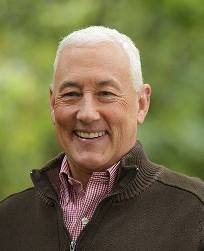It’s All Relative: Indiana Edition, Part II
Slightly more than 1 in 20 Hoosiers entering Congress since statehood had a family member precede them in one of the two legislative chambers

Last week, Smart Politics highlighted eight Indiana lawmakers who served with family members in Congress over the last two centuries. On Tuesday, Mike and Steve Braun will attempt to win their respective U.S. Senate and 4th Congressional District primaries to move one step closer to adding their names to that list.
Also famously running for Congress in the state’s open 6th CD race this cycle is Republican Greg Pence (pictured) – older brother of Vice-President, former governor, and former five-term U.S. Representative Mike Pence.
The elder Pence is seeking to become the 20th lawmaker from Indiana who was preceded in Congress by another family member.
All told, slightly more than five percent of the nearly 350 Hoosiers to serve in either of the two legislative chambers since statehood were not the first to do so in their family (19 of 349, or 5.4 percent).
A few of these members were highlighted in last week’s report – having also served simultaneously with their relative on the Hill:
- Republican U.S. Representative Frederick Landis (1903-1907): brother of Republican U.S. Representative Charles Landis (1897-1909)
- Democratic U.S. Representative John Peterson (1913-1915): cousin of Ohio Democratic U.S. Representative Horatio Claypool (1911-1915; 1917-1919)
- Democratic U.S. Representative Tim Roemer (1991-2003): son-in-law of Louisiana Democratic U.S. Senator J. Bennett Johnston (1972-1997)
Two Hoosiers who took office in the 21st Century had a family member help blaze their trail to the Hill – including one current member of the state’s delegation:
- Republican U.S. Representative Brian Kerns (2001-2003): son-in-law of Republican U.S. Representative John Thomas Myers (1967-1997)
- Democratic U.S. Representative André Carson (2008-present): won a special election after the death of his grandmother, Julia Carson (1997-2007)
Ten members of Congress from Indiana – including the aforementioned Representatives Landis, Peterson, and Roemer – took office during the 20th Century by following in the footsteps of a family member:
- Democratic U.S. Representative Sam Pettengill (1931-1939): nephew of Montana Republican Delegate William Clagett (1871-1873)
- Democratic U.S. Representative John Boehne, Jr. (1931-1943): son of Democratic U.S. Representative John Boehne (1909-1913)
- Republican U.S. Representative Charles La Follette (1943-1947): great-grandson of Republican U.S. Representative William Heilman (1879-1883)
- Democratic U.S. Representative Winfield Denton (1949-1953; 1955-1966): son of Democratic U.S. Representative George Denton (1917-1919)
- Republican U.S. Representative Shepard Crumpacker (1951-1957): cousin of Republican U.S. Representative Edgar Crumpacker (1897-1913) and Oregon GOP U.S. Representative Maurice Crumpacker (1925-1927)
- Democratic U.S. Representative Andrew Jacobs, Jr. (1965-1973; 1975-1997): son of Democratic U.S. Representative Andrew Jacobs (1949-1951)
- Democratic U.S. Senator Evan Bayh (1999-2011): son of Democratic U.S. Senator Birch Bayh (1963-1981)
Seven Hoosiers entering Congress in the 1800s were preceded by a relation:
- Democratic U.S. Representative (1851-1855) turned Republican U.S. Senator (1863-1869) Thomas Hendricks: nephew of Jeffersonian-Republican U.S. Representative (1816-1822) and Adams/National Republican U.S. Senator William Hendricks (1825-1837)
- Republican U.S. Representative James Lane (1853-1855): son of Jacksonian U.S. Representative Amos Lane (1833-1837). Note: James Lane later became a U.S. Senator from Kansas (1861-1866).
- Democratic U.S. Representative James A. Cravens (1861-1865): second cousin of Whig U.S. Representative James H. Cravens (1841-1843)
- Democratic U.S. Representative John Law (1861-1865): grandson of Connecticut Pro-Administration U.S. Representative Amasa Learned (1791-1795) and son of Connecticut Federalist U.S. Representative Lyman Law (1811-1817). John Law was also the grandson of Continental Congress member Richard Law of Connecticut (1777; 1781-1782).
- Democratic U.S. Representative Joseph Edgerton (1863-1865): brother of Ohio Democratic U.S. Representative Alfred Edgerton (1851-1855)
- Republican U.S. Senator Benjamin Harrison (1881-1887): grandson of Ohio Jeffersonian-Republican U.S. Representative (1816-1819) and Adams U.S. Senator (1825-1828) William Henry Harrison
- Democratic U.S. Representative William E. English (1884-1885): son of Democratic U.S. Representative William H. English (1853-1861)
As documented in last week’s report, in addition to the 19 U.S. Representatives and U.S. Senators listed above, one Indiana lawmaker – Republican U.S. Representative Henry Sayler (1873-1875) – entered Congress at the exact same time as his cousin, Ohio Democratic U.S. Representative Milton Sayler (1873-1879).
Ten other Indiana members of Congress took office before a relative of theirs served in the U.S. House or U.S. Senate from another state. The most recent of these is Republican U.S. Representative (1977-1981) and U.S. Senator (1981-1989) Dan Quayle, father of Arizona Republican U.S. House member Ben Quayle (2011-2013).
Greg Pence will face four primary opponents in Tuesday’s contest: retiree and perennial candidate Mike Campbell, economist Jonathan Lamb, businessman and U.S. Air Force reservist Stephen Mackenzie, and manufacturing trainer Jeff Smith.
Follow Smart Politics on Twitter.

In the wake of the primary victory by the elder Pence – and given the prohibitively R lean of the Muncie-based constituency (which also includes some outer suburbs of both “Indy” and “Cincy”) – both Pences are poised to serve simultaneously in the next Congress (1 of 2019 to early January of 2021), albeit only one of whom as a “member” (the vice president, by constitutional designation, is the President of the Senate, though that is classified as an officer of the institutuion. Nonetheless…).